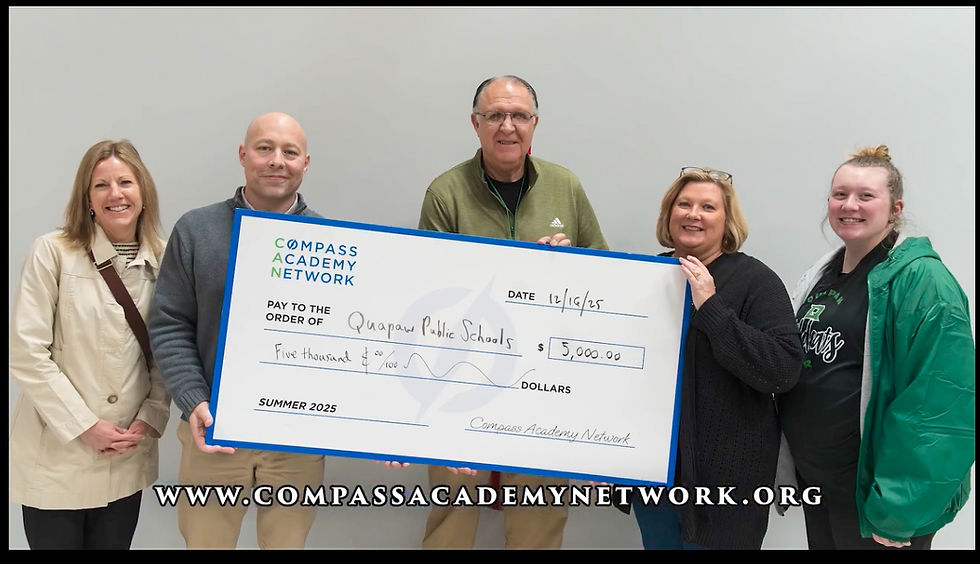Inside the Archeological Survey
- Austin Headlee
- Sep 6, 2022
- 3 min read
Updated: Nov 7, 2022
Quapaw Nation elders and the Business Committee ventured to the University of Arkansas Museum in Fayetteville, Ark. on September 22 to view long-lost Quapaw artifacts. The Arkansas Archeological Society took the groups behind the scenes of the museum, which allowed the visitors to get a closer look at the artifacts.
The museum’s archivist opened the vault and brought out artifacts, such as wooden bowls and pottery designed by Quapaw ancestors and dice made from bones, to present to the visitors in a controlled setting.
Quapaw pottery is identifiable from its use of red clay and swirling patterns. Every piece of pottery was made with the intent of being functional. Even pieces designed in the shape of animals, the Quapaw ancestors ensured that they had a function.
Quapaw pottery and most ceramics must avoid extreme heat and cold temperatures and rest within a specific relative humidity range (RH). The artifacts are stored in the vault in a regulated environment of approximately 70 degrees with a 40-50% RH to prevent deterioration of the museum’s pieces.

Following the visit to the vault, the Quapaw elders and Business Committee sat on a presentation from the Arkansas Archeological Society. The presentation included details about how the archeological team surveys the land and how they protect any artifacts they may find during their trips in the field. They also discussed essential landmarks from the Quapaw Tribe’s time in Arkansas.
The Quapaw ancestors were located throughout Arkansas before being relocated to northeast Oklahoma due to the 1833 treaty. The archeologist’s diligence in the field is crucial for protecting and retaining critical cultural artifacts for the Quapaw Nation.
Wallace Bottom, a colonial-era archeological site found in 1998 along the lower reaches of the Arkansas River, was found containing Quapaw and French artifacts. Wallace Bottom, located near Lake Dumond, is believed to include a portion of the Quapaw village Osotouy and the first Arkansas Post.
The Arkansas Post was the first European establishment in Arkansas and the most significant for the Quapaw Tribe. According to Encyclopedia of Arkansas, the Quapaw people were eager to trade with the French to establish an alliance and trade partner. Fur was by far the most heavily traded item at the Post.
Following the Arkansas Archeological Society’s presentation, Grace Goodeagle posed a thought-provoking question about the historic Quapaw mounds. Goodeagle asked the archeologists about their efforts to explore and identify the mounds’ contents without disrupting the mounds’ integrity.
The archeologists responded to Goodeagle’s questions by discussing the process of LiDAR, a method of light detection and ranging to detect the shells of mounds. They went on to say that mounds are a cultural phenomenon found worldwide and the importance for cultural preservation.

A traditional meal was served to show the Quapaw’s appreciation to the museum for setting up the presentations. Before entering the dining hall, all guests were smoked off and blessed, as is custom before Quapaw meals. Frybread, beef and hominy, corn, grape dumplings, wild rice and more were served during the feast, followed by cake and cobbler. Carrie V. Wilson was the lead cook for dinner after the presentation. Wilson was essential in organizing the event, allowing the Quapaw people to view their ancestral artifacts.
The visit with the Arkansas Archeological Society provided an excellent networking opportunity for the Quapaw Nation. It is important to maintain these connections to ensure Quapaw artifacts are adequately taken care of and to collaborate for future events. To show their gratitude to the museum for allowing the Quapaw Nation to go into the vault and for the presentation, Chairman Joseph Byrd robed Dr. Alex Barker as a sign of respect and thanks.






Comments